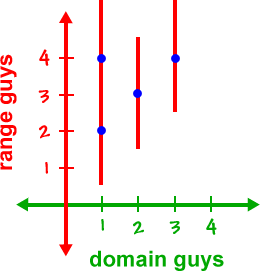Here's the official definition:
|
A
rule is a function if
|
Check out this guy:
![]()
Let's graph those points:
 |
R
is NOT a function since one element in the
domain (1)
goes to two elements in the range
(2 and 4.) Or, you can just say that R is not a function since 1 goes to 2 AND 1 goes to 4. So, it fails the vertical line test! |
YOUR TURN:
| Is |
|
|
a function? |
|
* put the letters along the bottom since they are the domain guys!
Is this a function?
![]()
* now the numbers go along the bottom!